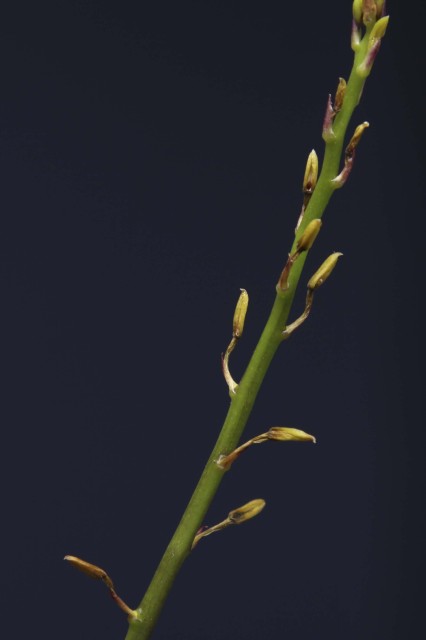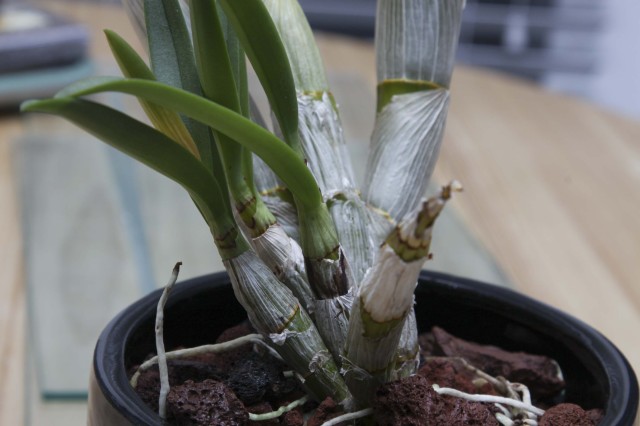Question Dendrobium
Dendrobium
QUESTION: So here's what happened. I've never had this happen before, this dendrobium was chugging along and appeared to be doing really well.
As it started to flower my friend moved it to an island in our kitchen which has halogen lights probably 24 inches above where the top of the spikes were. I was pretty careful about not over watering the plant over the past few months. Watering it roughly once every 5-7 days. The medium is lava rocks, orchid pot with holes in the sides, not over packed - so it's definitely not ever sitting in water. In fact, I questioned whether or not I was watering the plant enough, but the roots appeared to remain relatively healthy.
I'd like to put the cause of death of the flowers on them being fried under the halogen bulbs? However I'm guessing that over/under watering would cause a similar demise?
Literally though, the spikes began to flower while I was out of town and she moved the plant to under the halogen lights within 48 hours of the first sign of flowers thinking we were about to enjoy a beautiful plant!
I've since moved the plant back to my filtered sun room with a fan.
On a side note, a couple of the lower outer leaves started to yellow a bit as well, not sure if that is related or not.
Presuming that we lost these spikes from potentially producing flowers, at what point should we cut them back in hopes of new spike down the road?
ANSWER: Steve, I think that your suspicions regarding the halogen lighting may be on target-- especially if your halogen lighting is from a 250 Watt bulb or higher. Those bulbs generate a great deal of heat. If you have a warm growing dendrobium where the flower spike grows upright where the buds/flowers are closest to the light, they would also receive the most heat. Best allow the plant to remain in the location where flower spikes were produced and go to term (flower) in that location. With regard to the lower leaves, that would not likely be due to the heat as one would expect the leaves closest to the light to be affected. It is natural for a dendrobium to lose one or more lower leaves as those are the oldest.
Most dendrobiums will not rebloom on the same spike but will send up new flower spike(s) during the next blooming cycle. Cutting the old bloom spikes back is not likely to have any effect on future flowering.
---------- FOLLOW-UP ----------
 Base of Plant
Base of Plant
QUESTION: Thanks for the information. I was wrong on the lights however. I'm told they were rarely on and after closer examination, although it is a halogen spot it looks to be only a 50 watt pin spot and I kept them running for a bit and there was minimal heat 6" from the bulb closes to where the plant was. Taking the halogen light out of the equation, any thoughts?
You can see the leaf on the left turning slightly yellow at the base.
It's a fairly tall plant, 18" at the tallest point before the spikes.
AnswerWell, so much for that idea. I assume from your remarks, that you have flowered this plant before. I also assume that no name tag accompanied the plant when you received it. I notice more and more orchid plants are coming without names. Commercial mass marketers seem to be insensitive to plant identification at a time when people buy orchid plants to grow them just like other house plants. A name, if a registered cross, would allow us to pinpoint the parental species and their growing conditions in nature. I have also found many plants mislabeled. For example, some dendrobiums prefer a rest period before resuming growth. For these dendrobiums, continuing to water and feed signals a premature start of spring and the new growth and eventually weakens the plant. I appears, however, that your most recent growths are the strongest so keep doing what you are doing. Dendrobiums really thrive with lots of heat, light, and air movement.
There are lots of possible explanations for flowering failure. I may be that with the 50 watt spot halogen may have been insufficient light for flowering. I have found that moving plants at the critical stage of flowering can cause the effects you observed. This is because the whole environment (eg light intensity, light duration, humidity, etc) are changed and any one of these can affect flowering. Best, whenever possible, to maintain a constant environment.







